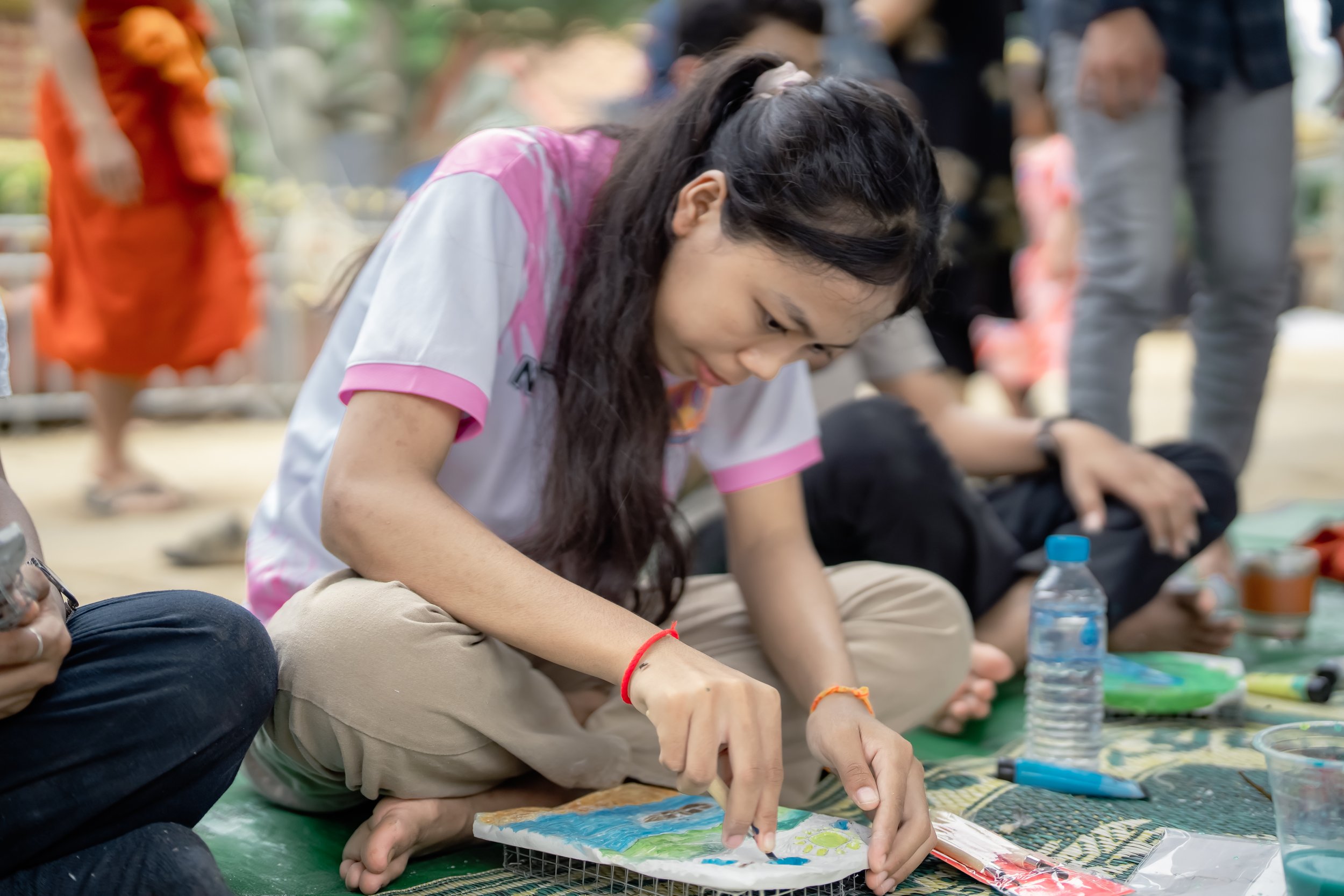My Own Words: NomadiX, art tour for the community
Workshops by tiSamjort collective for Cambodia’s rural communities
By Lyna Kourn
'My Own Words' is a monthly series which features personal essays by practitioners in the Southeast Asian art community. They deliberate on their locality's present circumstances, articulating observations and challenges in their respective roles.
Students in the workshop. Photo taken in 2024. Image courtesy of NomadiX.
Art has long served as a medium for capturing, reflecting, and responding to human experiences. Can one-day events create a powerful yet fleeting impact on communities? This essay explores the significance of a one-day art event, emphasising its role in fostering community engagement, encouraging spontaneity, and challenging conventional notions of artistic permanence within local communities in Cambodia.
NomadiX is an art tour that provides workshops on basic art skills, opportunities, and knowledge. Established in 2020 by the tiSamjort collective, composed of artists Sao Sreymao, Neak Sophal, Tan Vatey, and Say Tola, NomadiX was created in response to the lack of access to visual art education in the country. It represents a shared vision among friends and like-minded individuals committed to community-centred art engagement. NomadiX empowers communities to address environmental and climate change issues through art. This initiative aims to inspire creativity, nurture resilience, and drive lasting positive change in Cambodia's rural communities.
In 2024, NomadiX took place in three locations, specifically at pagodas in three provinces: Wat Serei Sakor in Koh Kampong Trom, Kampong Cham Province; Wat Manhchak Sela Thmo Kre in Kratie Province; and Prasath Preah Kor in Stung Treng Province. In Cambodian culture, pagodas hold significant religious and social importance, serving as centers for spiritual practice, community gatherings, and cultural heritage. The event was supported by the Swiss Agency for Development in Cambodia and implemented by NGO Forum, Anica Foundation, and the tiSamjort collective, along with local volunteers.
Students in the workshop. Photo taken in 2024. Image courtesy of NomadiX.
Students in the workshop. Photo taken in 2024. Image courtesy of NomadiX.
As a volunteer at the event, I had observed many workshops in Phnom Penh, the country's capital. However, I was curious about the experiences in rural areas and how participants would respond. The ephemeral quality of one-day art events resonates deeply with me; like a blooming flower, they exist only briefly before vanishing. These events demand immediate engagement from both artists and the audience, relying on the collective energy of participants to create shared experiences. This fosters social bonds and a sense of community ownership.
From 6:30 AM to 11:30 AM, four hands-on workshops were conducted:
Photography - Photo printed on wood by artist Neak Sophal, a photographer, who graduated from the Royal University of Fine Arts.
Videography - Stop motion by artist Mech Sereyrath, a visual artist and filmmaker, who graduated from the Royal University of Phnom Penh.
Fine Arts by artist Sao Sreymao, a comic and visual artist from Phare, a private art school in Battambang.
Mixed Media by artist Prak Dalin, a visual artist and architect, who graduated from the Royal University of Fine Arts.
All workshops were held under the trees, and addressed the theme of art, community, and environment. Secondary and high school students actively participated and focused on expressing their feelings through their creations rather than engaging in conversation. They learned valuable skills to articulate environmental issues within their community. While initially curious and shy around strangers, they also exhibited excitement and eagerness to explore. The artist-instructors guided the students through hands-on activities that fostered creativity and self-expression.
After the morning workshops and a lunch break, students displayed their work in a one-day art exhibition held under the trees for the community. Concurrently, a panel discussion was conducted on "The Role of Art in Raising Awareness about Environmental and Climate Change Issues" featuring speakers such as the four artists, monks, and local authorities. They emphasised the importance of art in addressing environmental challenges, although the concept of a panel discussion was relatively unfamiliar to the community.
Both students and the audience were impressed by the results of the workshops. The atmosphere was akin to playtime, emphasising the joy of creativity. This is similar to "pop-up" art installations that appear and disappear within a single day, leveraging elements of surprise and novelty to encourage spontaneous engagement with art.
The afternoon progressed quickly, akin to a time-lapse. Activities concluded with an evening of film screenings and a spectacular art performance by local troupes. The screening included videos created by students during the workshop, snapshots from scouting activities, and seven educational films related to the environment. This allowed more community members to participate as they gathered at the pagoda. Later in the evening, local performing troupes showcased Khmer classical dance, folk dance, a traditional Khmer costume fashion show, Lakon Basac (traditional Khmer theatre), and spoken theatre.
People watched the performance under the rain. Photo taken in 2024. Image courtesy of NomadiX.
People watched the performance under the rain. Photo taken in 2024. Image courtesy of NomadiX.
People watched the performance under the rain. Photo taken in 2024. Image courtesy of NomadiX.
The unpredictability of the event heightened excitement and exclusivity, fostering a deeper connection within the community. In Kratie Province, despite the rain, performances continued, and the audience remained engaged, applauding to encourage performers. The opportunity to experience such performances in the rural areas is rare, and I felt a strong sense of community support and enthusiasm for the event.
These events serve as a platform for local talent and provide space for experimentation and innovation among youth, facilitating the exploration of art and environmental issues relevant to their community. The collaborative nature of these events enriches the youth's experiences and encourages dialogue and interaction among students and community members. While the event creates a bridge for conversation, visual art is inherently more complex than a single-day showcase. To integrate visual arts into everyday life in Cambodia, these practices can be woven into schools, public spaces, and community events. For example, curricula that include art education or public art installations reflecting local culture could enhance this integration. Using art to engage communities in discussions around climate change is essential, even for those unfamiliar with the topic. Expanding the workshop duration could offer more time for participants to grasp these pressing issues.
Students searching for their artworks. Photo taken in 2024. Image courtesy of NomadiX.
Teachers with the students’ artworks. Photo taken in 2024. Image courtesy of NomadiX.
Students’ artworks. Photo taken in 2024. Image courtesy of NomadiX.
People watched the performance from the back stage. Photo taken in 2024. Image courtesy of Lyna Kourn.
In conclusion, NormadiX art tour aims to unlock art’s transformative power by inspiring youth, preserving Khmer and indigenous artistic heritage, and providing access to previously unavailable artistic education. Students are encouraged to reflect on their community’s challenges and express these issues through creative mediums. This event represents a compelling intersection of ephemerality, community engagement, and innovation. This approach aligns with the idea that art's significance can lie in its ability to evoke a profound, immediate response rather than its capacity to endure over time. By embracing the fleeting quality of these events, artists and audiences alike are invited to engage in art in a way that is immediate, dynamic, and deeply personal. The value of art is measured not by its durability but by the profound impact one can have on a single, unforgettable transformative day in human memory.
About the Writer
Born and raised in Phnom Penh, Cambodia, Lyna Kourn graduated with a BA in Business Management in 2012. Starting in 2015, Lyna developed a passion for storytelling while working at Sa Sa Art Projects, the leading contemporary arts institution in Cambodia. She is committed to championing diverse voices and sharing untold stories through her productions, believing deeply in art and cinema's ability to inspire, provoke thought, and foster empathy across cultures. Looking forward, Lyna is enthusiastic about exploring new genres, collaborating with talented filmmakers and artists, and pushing the boundaries of storytelling techniques.
























